SUMMARY
This is AI generated summarization, which may have errors. For context, always refer to the full article.

This draft updates the analysis published on August 22, 2016, covering fatalities linked to the anti-illegal drugs campaign in the Philippines from June 30 to August 18, 2016. The analysis in this update covers 1,727 fatalities, as reported by the Philippine Daily Inquirer over the extended period up to December 8, 2016.
We acknowledge that this dataset is only a partial one, since other unofficial estimates now place the total number of fatalities at over 6,000. Nevertheless, we try to leverage the details on fatalities reported by the Inquirer; and the disaggregated analysis herein does show some important patterns that could be useful for policymakers and stakeholders.
As an initial screening device, for example, one can already identify jurisdictions with relatively more fatalities – and policymakers and advocates can prioritize these in their investigation and inquiry. And while some jurisdictions like Metro Manila, Cebu, Bulacan and Quezon are epicenters of fatalities, there are also places where there are barely any fatalities linked to the anti illegal drugs campaign like Aurora, Palawan and Siquijor notwithstanding large numbers of drugs surrenders in these areas. The analysis here emphasizes the widely varying patterns on these fatalities.
Unidentified assailants
Once again, we begin by classifying the fatalities into three main contexts:
- fatalities linked to police operations;
- fatalities linked to assassins (including hitmen “riding in tandem”); and
- citizens found dead (or “salvage” victims).
Of those fatalities linked to police operations, we further disaggregate according to:
- fatalities resulting from police buy-bust operations and shootouts;
- fatalities resulting from serving arrest warrants;
- fatalities resulting from attempting to escape arrest; and
- fatalities resulting from serving a search warrant.
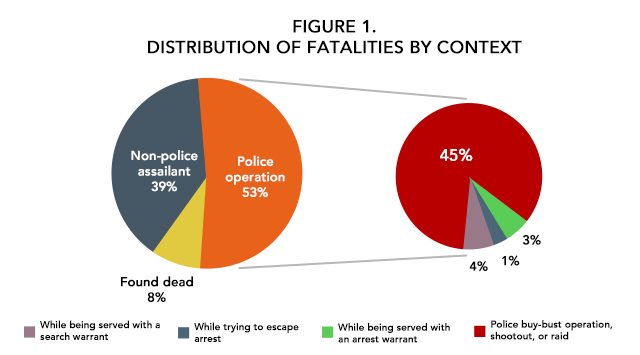
Among the 1,727 fatalities under analysis, 783 fatalities (53% of the total) were linked to police operations, 680 fatalities (39%) were linked to hitmen or by gunmen “riding in tandem”, 143 fatalities (8%) appeared to be salvage victims whose bodies were labeled with signage tags related to drugs.
Compared to our late August analysis, we note that fatalities due to unidentified assailants (i.e. not through police operations) have increased and now take a larger share of the total.
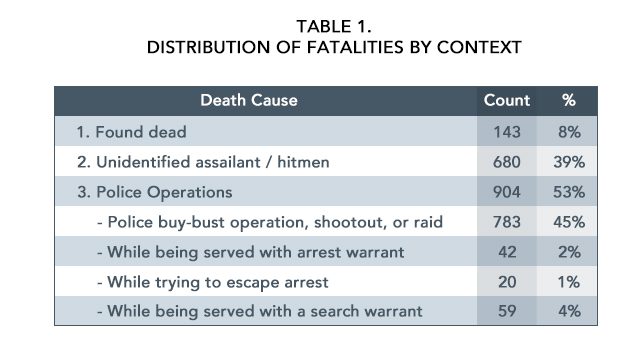
An analysis of the location of the fatalities points to some important patterns. Figure 2 shows the provinces/areas with at least 15 fatalities each.
Based on our analysis, mostly the same provinces and Metro Manila are still topping the list in terms of fatalities. On the other hand, figure 3 provides a biplot statistical analysis of which fatality type is most associated with each province/area/city. The intuition behind the biplot is that it tries to describe the patterns of associations among provinces vis-a-vis the specific context of the fatality (e.g. hitmen, police operation or found dead). Provinces near each other in the graph have similar profiles.
Highest: Metro Manila, Cebu
A province is associated with a particular context if it is plotted near the point represented by a specific context (e.g. police operations, hitmen, found dead). Larger size of points in the graph reflects higher frequency (e.g. among the causes, highest count of fatality can be attributed to police operations). From figure 2, several additional patterns emerge:
- Metro Manila has the highest number of fatalities, followed by Cebu, Bulacan, Quezon and Pangasinan. Zambales, Bulacan, North Cotabato, Camarines Sur, Laguna and parts of Metro Manila such as Quezon City, Manila and Navotas stand out due to the number of fatalities linked to police operations.
- Batangas, Pangasinan, Mandaluyong City, Marikina and Paranaque stand out due to the high number of fatalities linked to hitmen.
- Pasay City, Makati City and Nueva Ecija stand out in terms of salvage victims.
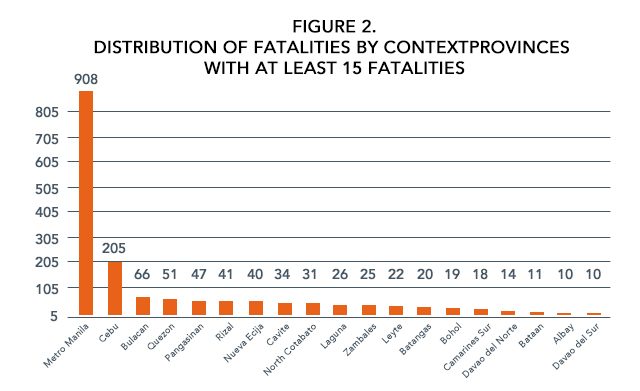
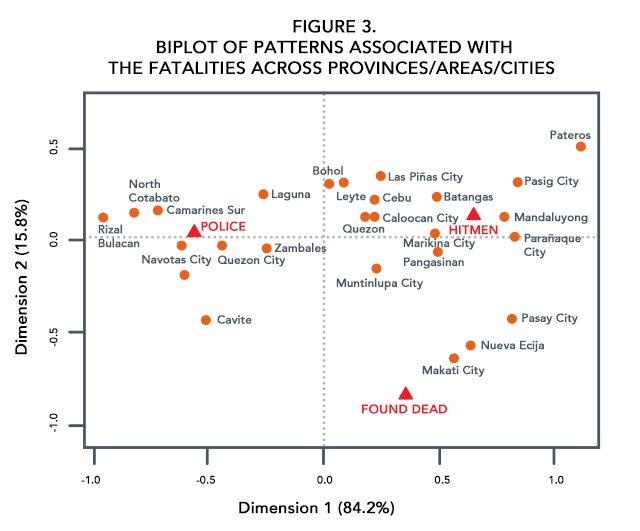
Caveat: Provinces/cities with less than 15 fatalities were excluded.
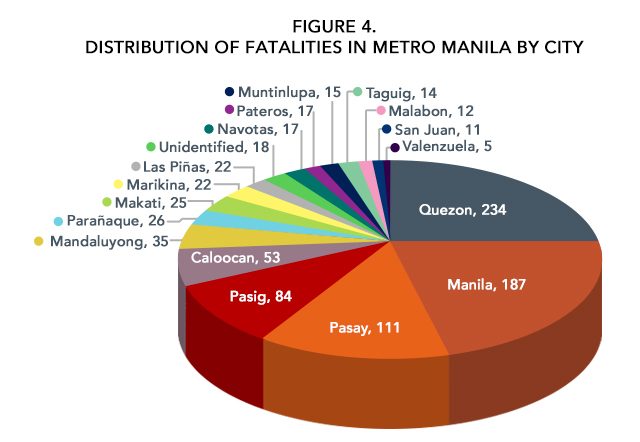
Compared to our late August analysis, Metro Manila again accounted for the vast majority of recorded fatalities. But its share of the total increased from 37% to over 52%. Given anecdotal evidence that the market for illegal drugs is strongest in the urban areas, perhaps many expected that the main frontlines would be in the country’s center.
If one breaks down the Manila-located fatalities by police jurisdiction, the Quezon City Police District and the Southern Police District accounted for well over half of the fatalities under analysis. As we mentioned before, since some of the fatalities are dead bodies found, it is still not clear whether these murders were committed in the jurisdictions where they were actually found. Clearly, a large number of cases need to be investigated in these jurisdictions.
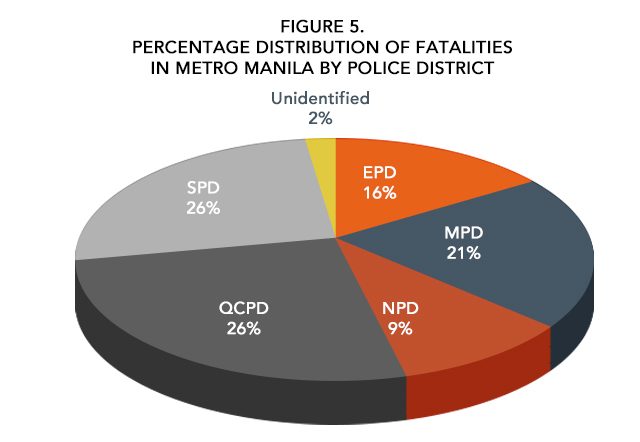
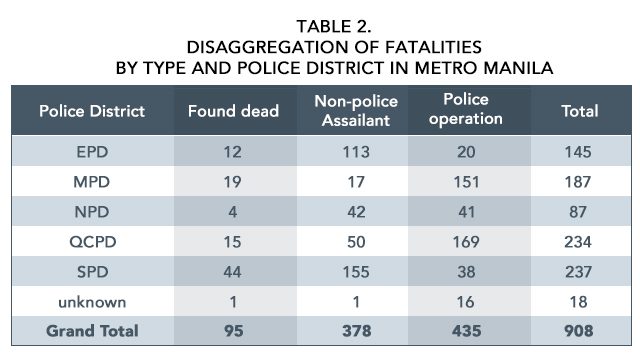
From the analysis herein, it is clear that the anti-illegal drugs campaign has generated widely varying results across police and local government jurisdictions. It is critically important not to generalize, and instead to recognize that in the country’s highly decentralized set-up it is possible that both islands of good governance and bad governance exist.
To illustrate, many are found dead in Makati City and Nueva Ecija. On the other hand, police operations result in a relatively large number of deaths in QCPD and MPD. (While we don’t have the figure for the total number of police operations, we suspect that a large share of this results in fatalities particularly in QCPD and MPD.) Moreover, there are relatively more deaths due to hitmen in Mandaluyong and Caloocan City. And yet in some other provinces there are barely any fatalities from the anti illegal drugs campaign.
Tracking these results and documenting them religiously could aid investigation and enhance accountability in our security forces – if not now, then years from now. It is also clear that the rising number of fatalities not linked to police operations signals a disturbing trend that needs to be more vigorously investigated and immediately stopped.
In our earlier analysis, 26% of all fatalities were due to unidentified assailants, yet in this updated analysis, this category now accounts for 39% of all fatalities. There are troubling reports that police personnel are involved in these; and the PNP needs to shore-up its reputation by more vigorously investigating these allegations.
If the public loses trust in the capability of the Philippine National Police to maintain law and order, and if more and more citizens question the PNP’s adherence to the rule of law, then the anti-illegal drugs campaign risks weakening this institution, dramatically lowering its sustained effectiveness to combat drugs. – Rappler.com
(Authors’ note: The views expressed in this article are the authors’ and do not necessarily reflect those of the Ateneo de Manila University. Ronald U Mendoza is the Dean of the Ateneo School of Government (ASOG); and Miann Banaag is a statistician with ASOG.)
Add a comment
How does this make you feel?
There are no comments yet. Add your comment to start the conversation.